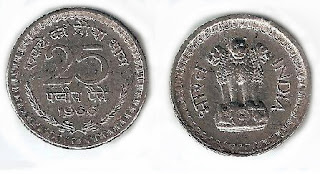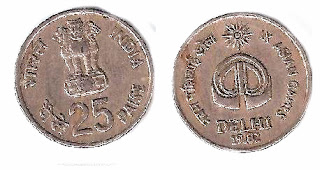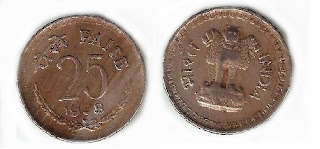25 paise
The Delhi Asian Games was the first Asiad to be held under the aegis of the Olympic Council of Asia (OCA). The Asian Games Federation, under whose jurisdiction the first eight Asian Games had been held, dissolved to make way for the OCA.
A total number of 4,595 athletes, coming from 33 countries, competed in this Asiad. Debut sports were equestrian, golf, handball, rowing, and Women's field hockey.These Asian Games also saw the beginning of Chinese dominance in the medals tally. Japan had won the most number of medals in previous editions of the Games. China made its presence felt in the sporting world by dethroning Japan as the top gold medalists.
In preparation for the IX Asian Games, colour television was introduced in India in a big way, as the Games were to be broadcast in colour.
The mascot for the Games was Appu – a kid elephant. Known in real life as "Kuttinarayanan", this elephant fractured its leg in an accident when he was seven years old – he stepped into a septic tank. That wound would not heal and it eventually killed him. Kuttinarayanan died on May 14, 2005.
Host of the next (10th) Asiad in 1986, and the 24th Summer Olympics in 1988, South Korea participated in the New Delhi Asiad with a 406-person delegation, including an observation team to study the facilities, management and events.
 |
| 25 paise 1966 |
India became independent on 15 August 1947 and was left with a legacy of non-decimal coinage. One rupee was divided into 16 annas or 64 pice, with each anna therefore equal to 4 pice. In 1957, India shifted to the decimal system, but for a short period both decimal and non-decimal coins were in circulation. To distinguish between the two pice, the coins minted between 1957 and 1964 have the legend "Naya Paisa" ("new" paisa). The denominations in circulation were 1, 2, 5, 10, 20, 25, 50 (naya)paise and one rupee which remained as the same pre-decimal value. Therefore pre-decimal coins of one, half and quarter rupees could remain in circulation after decimalisation.
Chronologically, the main considerations influencing the coinage policy of Republic of India over time have been: The incorporation of symbols of sovereignty and indigenous motifs on independence; Coinage Reforms with the introduction of the metric system; The need felt from time to time to obviate the possibility of the metallic value of coins rising beyond the face value; The cost-benefit of coinisation of currency notes.
The Ashok-Stambha (Ashoka's Pillar) is a motif on all Republic of India coins. The symbol is a representation of peace and non-violence.
Coin Description
Other Details
Other Details
25 Paise of 1966 - Kolkata Mint - No Mint Mark
Year:
1966
Diameter:
19.00 mm
Shape:
Circular
Mint Mark:
No Mint Mark
Coin Condition:
Very Fine (VF) to Uncirculated (UNC)
Remark:
Date and denomination smaller.
 |
| 25 paise 1982 IX ASIAN GAMES |
The 9th Asian Games were held from November 19, 1982 to December 4, 1982 in Delhi, India. This was the second time the Games were held in Delhi as it was also host to the inaugural 1951 Asian Games. New Delhi joined Bangkok (four times) as the only cities to host multiple editions of the Asian Games.
The Delhi Asian Games was the first Asiad to be held under the aegis of the Olympic Council of Asia (OCA). The Asian Games Federation, under whose jurisdiction the first eight Asian Games had been held, dissolved to make way for the OCA.
A total number of 4,595 athletes, coming from 33 countries, competed in this Asiad. Debut sports were equestrian, golf, handball, rowing, and Women's field hockey.These Asian Games also saw the beginning of Chinese dominance in the medals tally. Japan had won the most number of medals in previous editions of the Games. China made its presence felt in the sporting world by dethroning Japan as the top gold medalists.
In preparation for the IX Asian Games, colour television was introduced in India in a big way, as the Games were to be broadcast in colour.
The mascot for the Games was Appu – a kid elephant. Known in real life as "Kuttinarayanan", this elephant fractured its leg in an accident when he was seven years old – he stepped into a septic tank. That wound would not heal and it eventually killed him. Kuttinarayanan died on May 14, 2005.
Host of the next (10th) Asiad in 1986, and the 24th Summer Olympics in 1988, South Korea participated in the New Delhi Asiad with a 406-person delegation, including an observation team to study the facilities, management and events.
 |
| 25 paise 1985 |
India became independent on 15 August 1947 and was left with a legacy of non-decimal coinage. One rupee was divided into 16 annas or 64 pice, with each anna therefore equal to 4 pice. In 1957, India shifted to the decimal system, but for a short period both decimal and non-decimal coins were in circulation. To distinguish between the two pice, the coins minted between 1957 and 1964 have the legend "Naya Paisa" ("new" paisa). The denominations in circulation were 1, 2, 5, 10, 20, 25, 50 (naya)paise and one rupee which remained as the same pre-decimal value. Therefore pre-decimal coins of one, half and quarter rupees could remain in circulation after decimalisation.
Chronologically, the main considerations influencing the coinage policy of Republic of India over time have been: The incorporation of symbols of sovereignty and indigenous motifs on independence; Coinage Reforms with the introduction of the metric system; The need felt from time to time to obviate the possibility of the metallic value of coins rising beyond the face value; The cost-benefit of coinisation of currency notes.
The Ashok-Stambha (Ashoka's Pillar) is a motif on all Republic of India coins. The symbol is a representation of peace and non-violence.
 |
| 25 paise 1988 |
The reverse shows the Indian one-horned rhinoceros, once found in large numbers but now reduced to only a few thousand because of poaching for its horn, which has its uses as a medicine.Destruction of their habitat over the years, has brought the rhinos to the brink of extinction. These animals are among the worlds' most endangered species. The great one-horned rhino could once be found from Pakistan all the way through India, Nepal, Bangladesh, Bhutan and Myanmar. By the turn of the century, this species had vanished from much of its range, and today only about 2500 survive in India and Nepal. Throughout their range, their habitat continues to dwindle fast due to conversion of grassland habitats into agricultural fields and other human pressures. The threat of poaching continues to be ever-present.
 |
| 25 paise 1998 |
India became independent on 15 August 1947 and was left with a legacy of non-decimal coinage. One rupee was divided into 16 annas or 64 pice, with each anna therefore equal to 4 pice. In 1957, India shifted to the decimal system, but for a short period both decimal and non-decimal coins were in circulation. To distinguish between the two pice, the coins minted between 1957 and 1964 have the legend "Naya Paisa" ("new" paisa). The denominations in circulation were 1, 2, 5, 10, 20, 25, 50 (naya)paise and one rupee which remained as the same pre-decimal value. Therefore pre-decimal coins of one, half and quarter rupees could remain in circulation after decimalisation.
Chronologically, the main considerations influencing the coinage policy of Republic of India over time have been: The incorporation of symbols of sovereignty and indigenous motifs on independence; Coinage Reforms with the introduction of the metric system; The need felt from time to time to obviate the possibility of the metallic value of coins rising beyond the face value; The cost-benefit of coinisation of currency notes.
The Ashok-Stambha (Ashoka's Pillar) is a motif on all Republic of India coins. The symbol is a representation of peace and non-violence.

No comments:
Post a Comment